The Intel 12th Gen Core i9-12900K Review: Hybrid Performance Brings Hybrid Complexity
by Dr. Ian Cutress & Andrei Frumusanu on November 4, 2021 9:00 AM ESTCPU Tests: SPEC ST Performance on P-Cores & E-Cores
SPEC2017 is a series of standardized tests used to probe the overall performance between different systems, different architectures, different microarchitectures, and setups. The code has to be compiled, and then the results can be submitted to an online database for comparison. It covers a range of integer and floating point workloads, and can be very optimized for each CPU, so it is important to check how the benchmarks are being compiled and run.
For compilers, we use LLVM both for C/C++ and Fortan tests, and for Fortran we’re using the Flang compiler. The rationale of using LLVM over GCC is better cross-platform comparisons to platforms that have only have LLVM support and future articles where we’ll investigate this aspect more. We’re not considering closed-sourced compilers such as MSVC or ICC.
clang version 10.0.0
clang version 7.0.1 (ssh://git@github.com/flang-compiler/flang-driver.git
24bd54da5c41af04838bbe7b68f830840d47fc03)
-Ofast -fomit-frame-pointer
-march=x86-64
-mtune=core-avx2
-mfma -mavx -mavx2
Our compiler flags are straightforward, with basic –Ofast and relevant ISA switches to allow for AVX2 instructions. We decided to build our SPEC binaries on AVX2, which puts a limit on Haswell as how old we can go before the testing will fall over. This also means we don’t have AVX512 binaries, primarily because in order to get the best performance, the AVX-512 intrinsic should be packed by a proper expert, as with our AVX-512 benchmark. All of the major vendors, AMD, Intel, and Arm, all support the way in which we are testing SPEC.
To note, the requirements for the SPEC licence state that any benchmark results from SPEC have to be labeled ‘estimated’ until they are verified on the SPEC website as a meaningful representation of the expected performance. This is most often done by the big companies and OEMs to showcase performance to customers, however is quite over the top for what we do as reviewers.
For Alder Lake, we start off with a comparison of the Golden Cove cores, both in DDR5 as well as DDR4 variants. We’re pitting them as direct comparison against Rocket Lake’s Cypress Cove cores, as well as AMD’s Zen3.
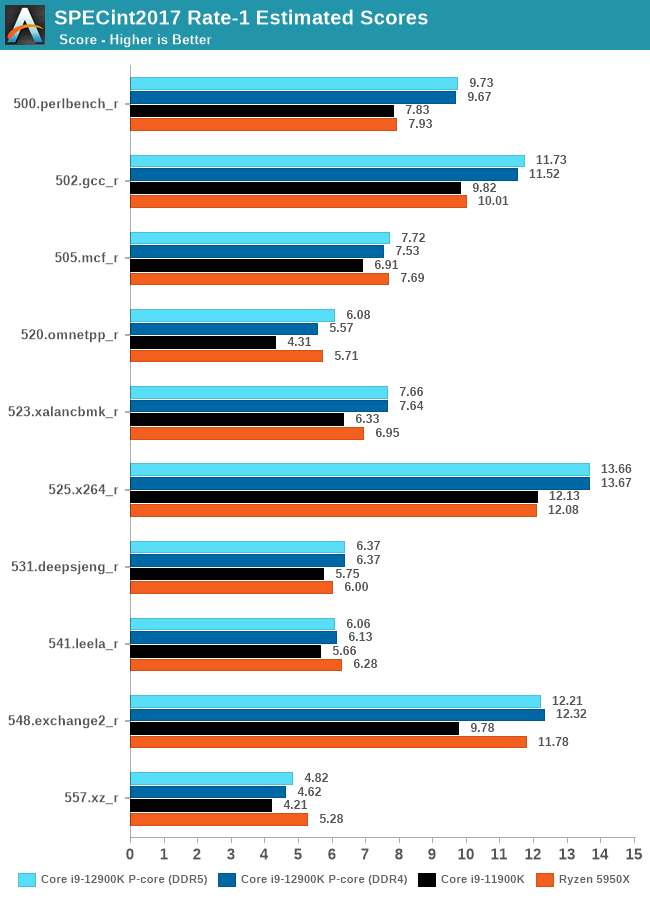
Starting off in SPECint2017, the first thing I’d say is that for single-thread workloads, it seems that DDR5 doesn’t showcase any major improvements over DDR4. The biggest increase for the Golden Cove cores are in 520.omnetpp_r at 9.2% - the workload is defined by sparse memory accessing in a parallel way, so DDR5’s doubled up channel count here is likely what’s affecting the test the most.
Comparing the DDR5 results against RKL’s WLC cores, ADL’s GLC showcases some large advantages in several workloads: 24% in perlbench, +29% in omnetpp, +21% in xalancbmk, and +26% in exchange2 – all of the workloads here are likely boosted by the new core’s larger out of order window which has grown to up to 512 instructions. Perlbench is more heavily instruction pressure biased, at least compared to other workloads in the suite, so the new 6-wide decoder also likely is a big reason we see such a large increase.
The smallest increases are in mcf, which is more pure memory latency bound, and deepsjeng and leela, the latter which is particularly branch mispredict heavy. Whilst Golden Cove improves its branch predictors, the core also had to add an additional cycle of misprediction penalty, so the relative smaller increases here make sense with that as a context.
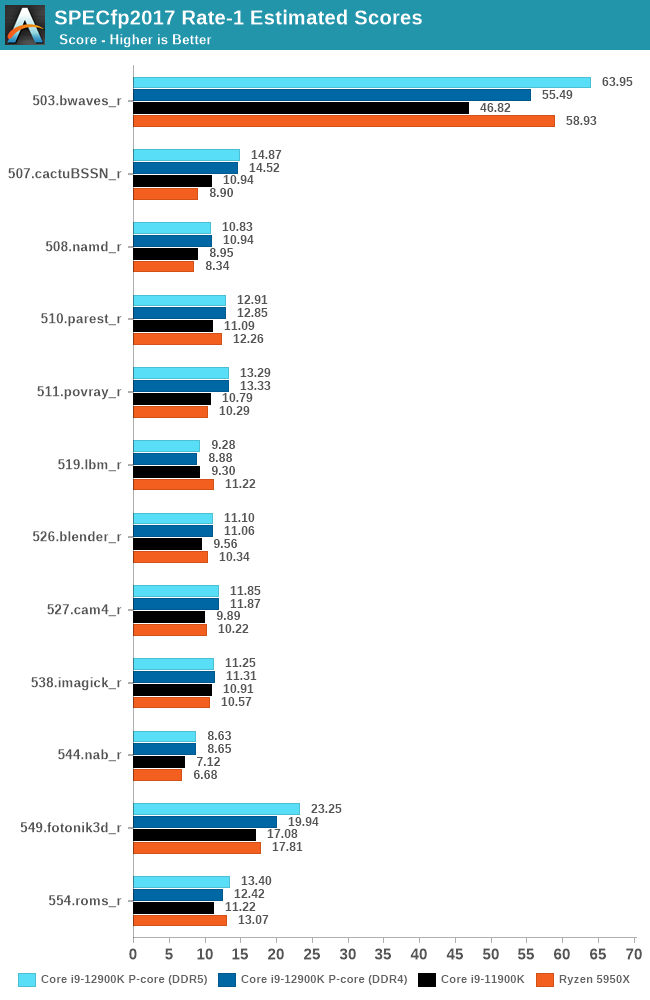
In the FP suite, the DDR5 results have a few larger outliers compared to the DDR4 set, bwaves and fotonik3d showcase +15% and +17% just due to the memory change, which is no surprise given both workloads extremely heavy memory bandwidth characteristic.
Compared to RKL, ADL showcases also some very large gains in some of the workloads, +33% in cactuBBSN, +24% in povray. The latter is a surprise to me as it should be a more execution-bound workload, so maybe the new added FADD units of the cores are coming into play here.
We’ve had not too much time to test out the Gracemont cores in isolation, but we are able to showcase some results. This set here is done on native Linux rather than WSL due to affinity issues on Windows, the results are within margin of error between the platforms, however there are a few % points outliers on the FP suite. Still, comparing the P to E-cores are in apples-to-apples conditions in these set of graphs:
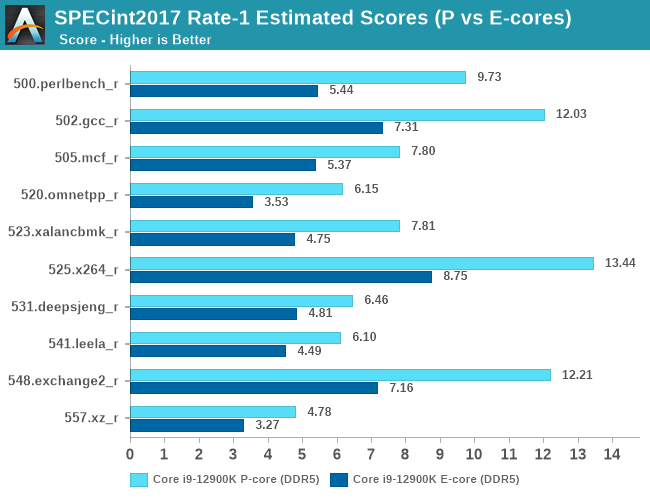
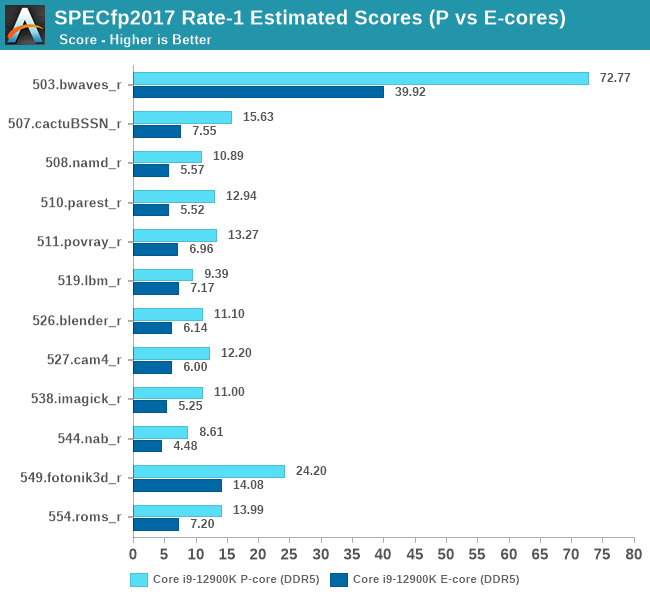
When Intel mentioned that the Gracemont E-cores of Alder Lake were matching the ST performance of the original Skylake, Intel was very much correct in that description. Unlike what we consider “little” cores in a normal big.LITTLE setup, the E-cores of Alder Lake are still quite performant.
In the aggregate scores, an E-core is roughly 54-64% of a P-core, however this percentage can go as high as 65-73%. Given the die size differences between the two microarchitectures, and the fact that in multi-threaded scenarios the P-cores would normally have to clock down anyway because of power limits, it’s pretty evident how Intel’s setup with efficiency and density cores allows for much higher performance within a given die size and power envelope.
In SPEC, in terms of package power, the P-cores averaged 25.3W in the integer suite and 29.2W in the FP suite, in contrast to respectively 10.7W and 11.5W for the E-cores, both under single-threaded scenarios. Idle package power ran in at 1.9W.
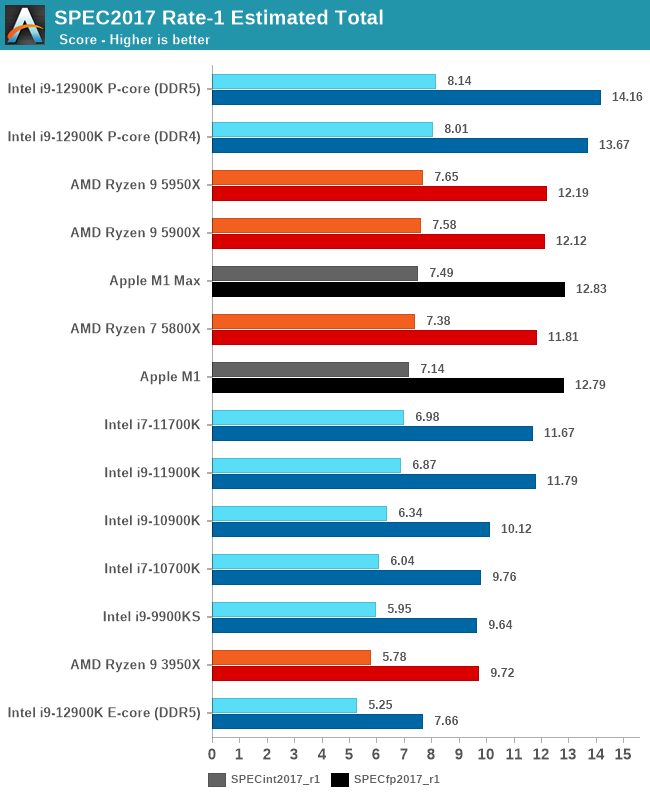
Alder Lake and the Golden Cove cores are able to reclaim the single-threaded performance crown from AMD and Apple. The increases over Rocket Lake come in at +18-20%, and Intel’s advantage over AMD is now at 6.4% and 16.1% depending on the suite, maybe closer than what Intel would have liked given V-cache variants of Zen3 are just a few months away.
Again, the E-core performance of ADL is impressive, while not extraordinary ahead in the FP suite, they can match the performance of some middle-stack Zen2 CPUs from only a couple of years ago in the integer suite.










474 Comments
View All Comments
5j3rul3 - Thursday, November 4, 2021 - link
Great step for intelBobbyjones - Thursday, November 4, 2021 - link
Indeed. Biggest improvements since sandybridge. If you look at the timeline, this wouldve been the first CPU designed since they saw Zen 1. This is their Zen 1 moment and they already took the performance crown back basically across the board and at a lower price. AMD is now on the back foot, and it will be another whole year before Zen 4, and the thing is, Zen 4 isnt even competing with Alder Lake, Raptor Lake is rumored to be out before Zen 4. AMD has really screwed up with their launch cycle and given Intel so much room that they not only caught back up but beat them. Intel is truly back.Netmsm - Thursday, November 4, 2021 - link
For now Threadripper has the performance crown.With this performance per watt, Intel can just win the market for PCs.
Enterprise will never accept this performance per watt! So, AMD wins the high profitable enterprise market.
12900k guzzles power up to 241! whereas 5950x consumes half!
Considering power consumption, it's like a Pyrrhic victory for Intel.
fazalmajid - Thursday, November 4, 2021 - link
The HEDT market in Enterprise is workstations, which run certified apps like AutoCAD and has a lot of inertia. The first real Zen workstation is the Lenovo P620 and it only recently came out, so AMD hasn't conquered that market yet. Most actual Enterprise desktops are compact models that typically run on laptop CPUs.DominionSeraph - Friday, November 5, 2021 - link
And Intel has AMD beat for miles in system validation.My 3950X on a x570 Phantom Gaming X has major issues with disk access across one NVMe, one SATA SSD, and two HDDs. Some things will start up fine, but some things will just HANG. Deus Ex loading screens take like 10 seconds. I just tried to play a video off my NVMe and it took ~15 seconds for it to launch MPC-HC. (further launches are fine.) MeGUI takes 15 seconds to launch.
This thing is just frustratingly slow in general desktop tasks compared to my old i7 4790.
Does it beat the pants off the 4790 in heavily multithreaded crunching? Yes. But iAMD does not put out a quality product.
Gothmoth - Friday, November 5, 2021 - link
anecdotal evidence? ....YOU have issues with your system.well we have 16 core ryzen and threadripper 32 & 64 core systems at work and we can´t complain.
it´s not as if intel is issue free (and i am not taking about security flaws).
when you have such grave issues.. YOUR system has issues.
probably a bad setup. i did not hear that starting MPC needs 15 seconds when i read abourt AMD systems.
dotjaz - Sunday, November 7, 2021 - link
What about USB issues that are publicly acknowledged AND multiple BIOSes claim to have fixed it, yet here we are.Netmsm - Friday, November 5, 2021 - link
It is your problem not AMD nor Intel!This is why we always refer to QVL of MB before buying RAM, SSD, etc. to avoid such problems. It is not AMD prerogative rather it is for all platforms.
For now you may better update MB bios as soon as it is released. To solve the problem completely you need to reassemble it according to the MB's QVL.
DominionSeraph - Friday, November 5, 2021 - link
It is an AMD issue. I've put together hundreds of Intel systems and none of them have any issues.Netmsm - Friday, November 5, 2021 - link
When you face abnormality just put your cards on the table and ask a pro.